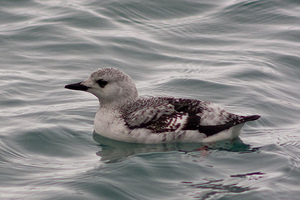Black guillemots feed by diving in relatively shallow water (usually less than 50 meters deep). Dives can last up to 2.5 minutes but usually are closer to 1 minute in duration, depending on water depth.
Photo Credit: Omar Runolfsson
Cepphus grylle
Common Name: black guillemot
Animal Guild: Bird
Class > Order > Family: Aves > Charadriiformes > Alcidae
What does the species look like?
Breeding adults are black, with a large white patch on each wing (coverts), nearly immaculate white underwing coverts, bright red legs and feet, slender black bill, and bright red mouth lining. Adults in nonbreeding plumage have white underparts and white-fringed black feathers on the head and upperparts, so they look mottled or finely barred; birds from arctic populations are much whiter. Juveniles are similar to winter adults but have more extensive dark mottling (especially on the head and neck), and the white patch on the upper wing surface is broken by blackish feathers. Sexes are alike in all plumages. Length is around 13 inches (33 cm).
Where is the species found?
States & Provinces
AK, MA, MB, ME, NB, NH, NJ, NL, NS, NT, NU, NY, ON, PE, QC, RI, YT
Distribution
Breeding range extends from the eastern Canadian Arctic and western Greenland south to the Gulf of Maine, east to the northern British Isles, Scandinavia, and Baltic Sea, and east along northern Russia to the Chukchi and Beaufort seas, including Alaska. In winter, most tend to stay near breeding areas (if open water is available).
Black guillemots nest in holes under rocks (rarely in ground) on rocky islands, among boulders at base of coastal cliffs, in or under beach flotsam and other human debris (e.g., in northern Alaska), or in coastal cliff crevices. In winter, they inhabit rocky seacoasts, open sea, or margins of landfast ice, seldom far from shore.
General Phenology and Life History
In North America, most go ashore to nesting sites in April-May. Nesting usually occurs in small groups or as single pairs. Eggs are laid mainly in May-June in southeastern Canada and in late June-early July in the Beaufort Sea area. Clutch size is 1-2. Incubation, by both sexes, lasts 23-39 days (average 4-4.5 weeks). Young are tended by both parents; most leave the nest area and are independent by 31-51 days. Most have departed nesting sites by the end of August.
Which phenophases should I observe?
Do you see/hear...?
Activity
Live individuals More...
For abundance, enter the number of individual animals observed in this phenophase.
Feeding For abundance, enter the number of individual animals observed in this phenophase.
Calls or song For abundance, enter the number of individual animals observed in this phenophase.
Territorial individuals For abundance, enter the number of individual animals observed in this phenophase.
Reproduction
Courtship For abundance, enter the number of individual animals observed in this phenophase.
Mating For abundance, enter the number of individual animals observed in this phenophase.
Nest building For abundance, enter the number of individual animals observed in this phenophase.
Occupied nest For abundance, enter the number of individual animals observed in this phenophase.
Development
Downy young For abundance, enter the number of individual animals observed in this phenophase.
Partially-fledged young For abundance, enter the number of individual animals observed in this phenophase.
Fledged young For abundance, enter the number of individual animals observed in this phenophase.
Dead individuals For abundance, enter the number of individual animals observed in this phenophase.
Dead nestlings or fledglings For abundance, enter the number of individual animals observed in this phenophase.
Method
Individuals at a feeding station For abundance, enter the number of individual animals observed in this phenophase.
What do these phenophases look like?
There is currently no photoguide available for this species. If you'd like help us create one, use the guidance document and species template provided here . Then send it via email to education@usanpn.org when it is complete.
